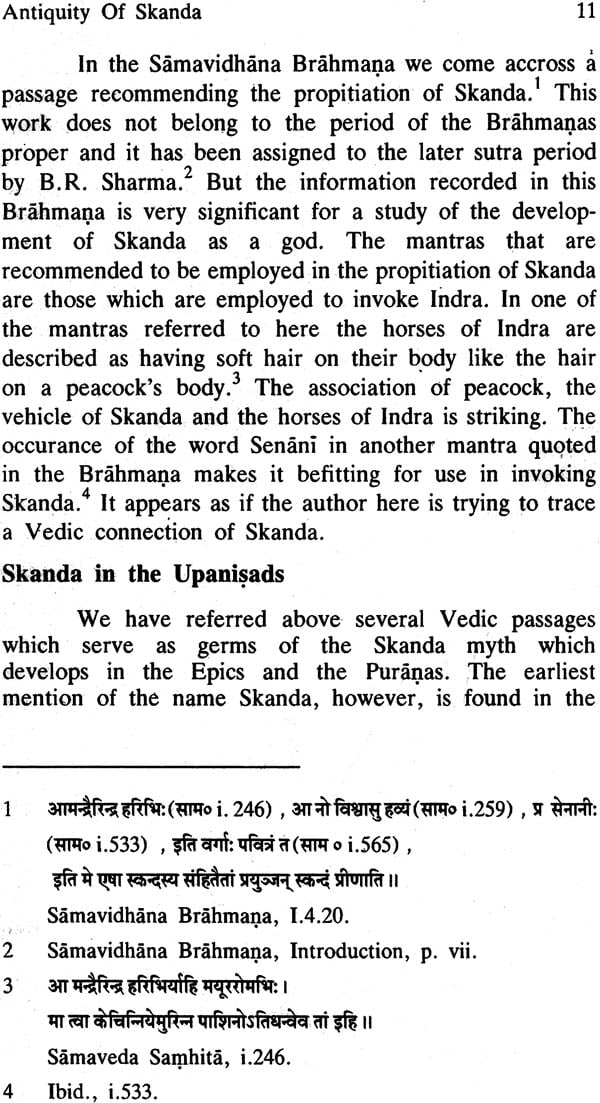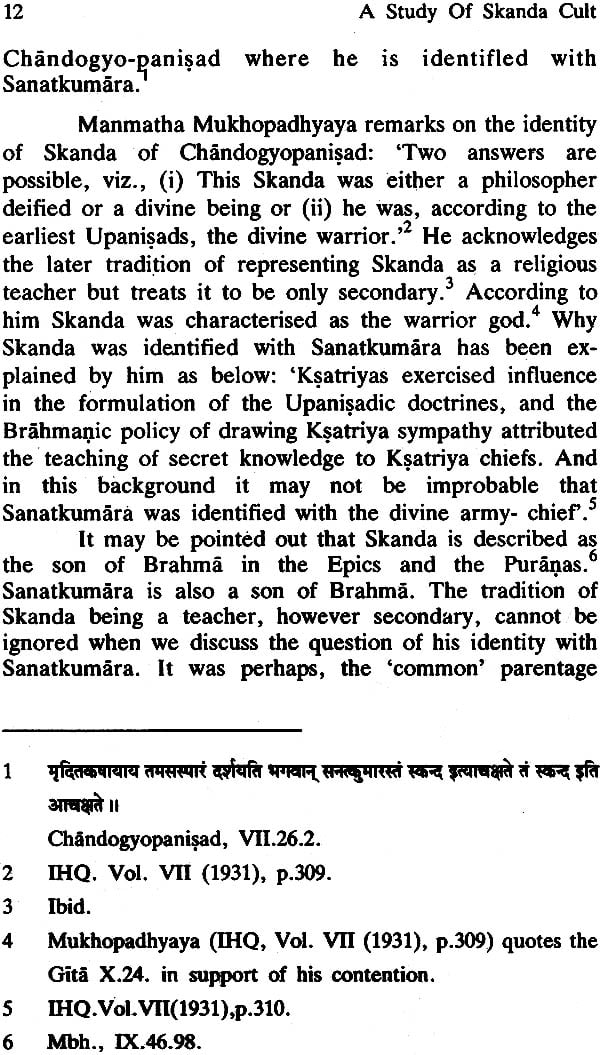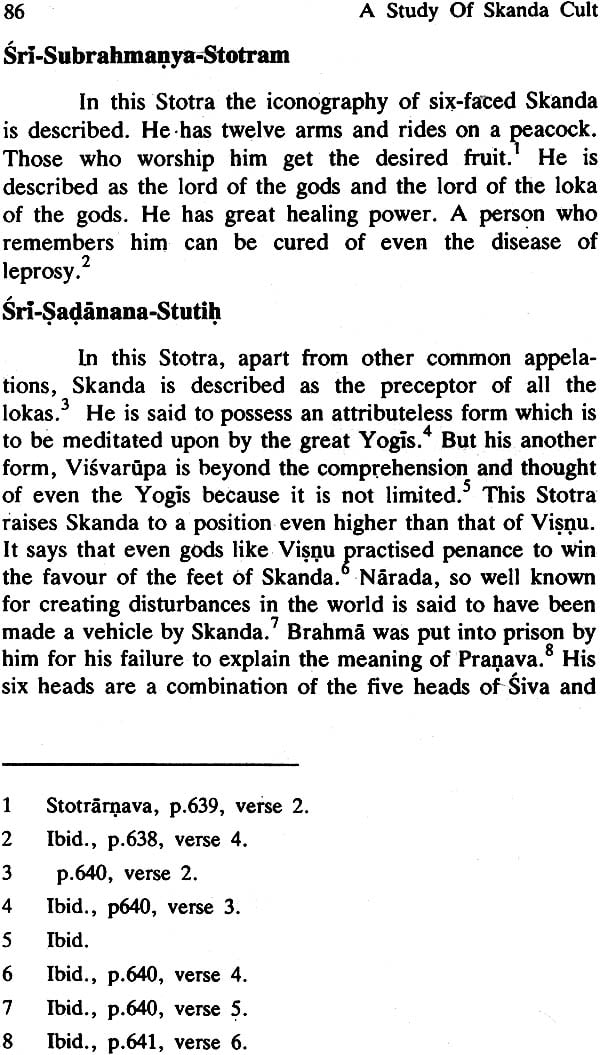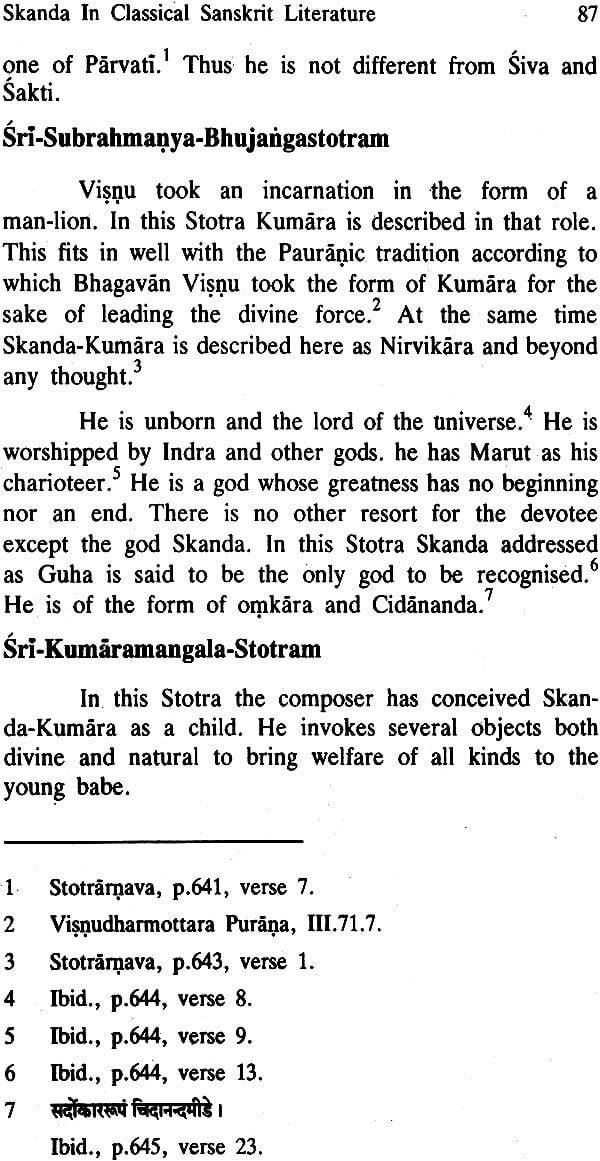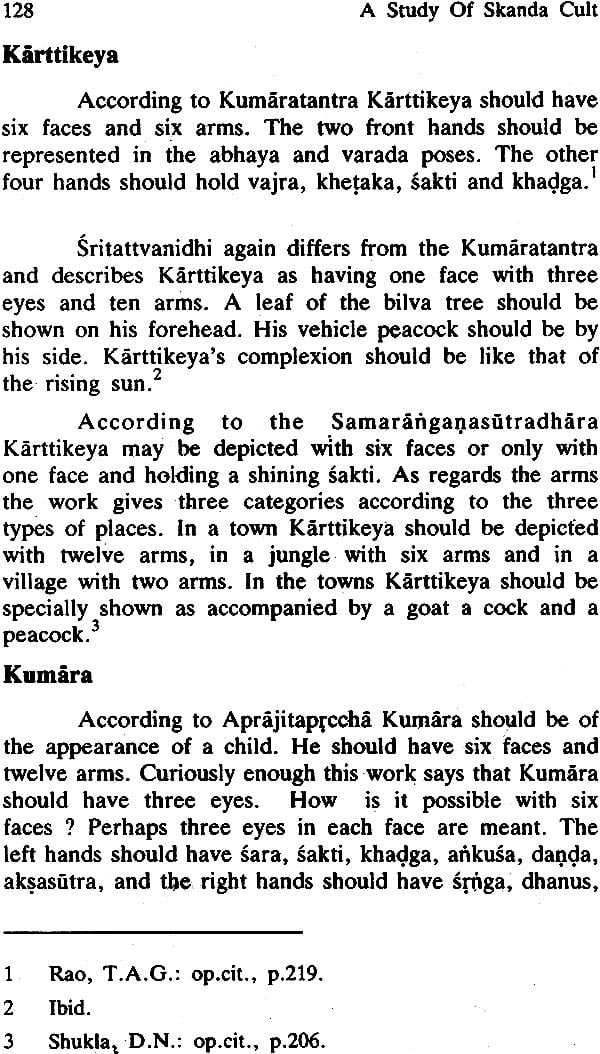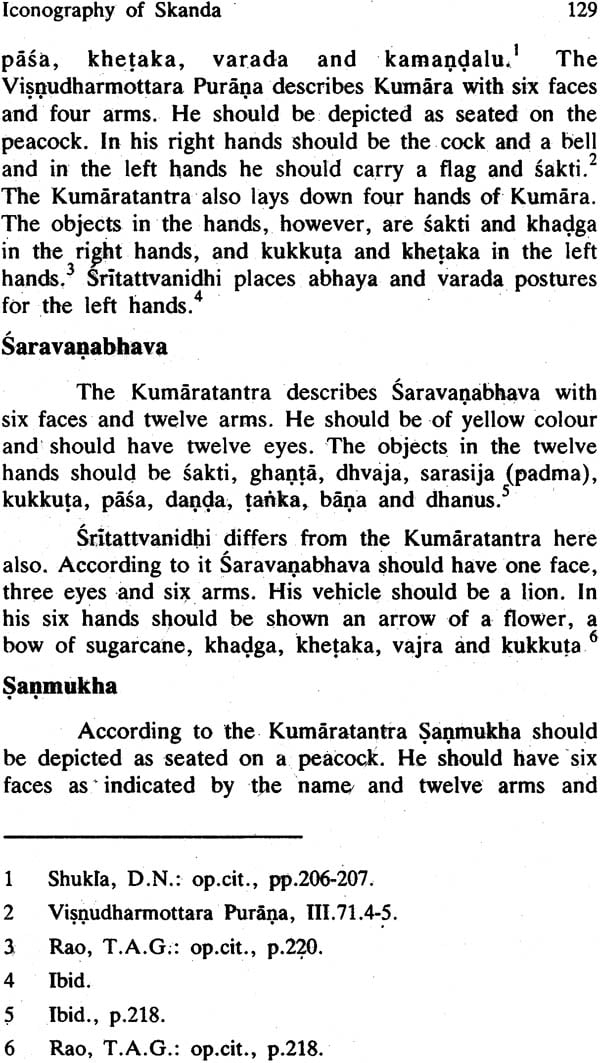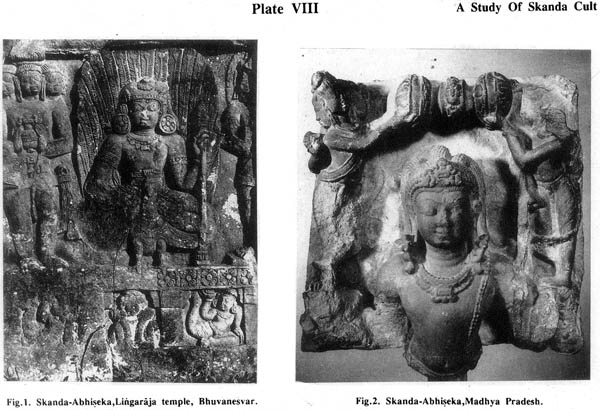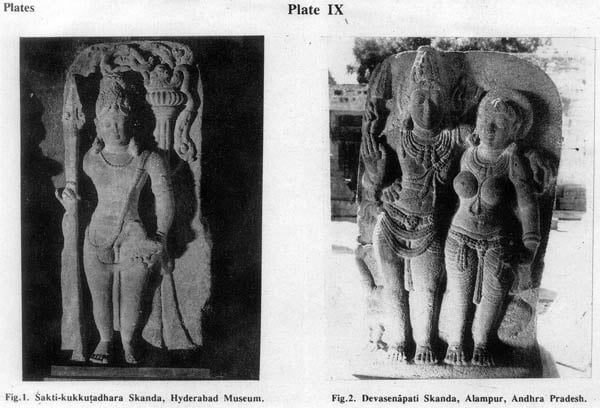
A Study of Skanda Cult
Book Specification
| Item Code: | IDE355 |
| Author: | S.S. Rana |
| Publisher: | Nag Publisher |
| Language: | English |
| Edition: | 1995 |
| ISBN: | 8170813034 |
| Pages: | 201 (B & W Illus: 33) |
| Cover: | Hardcover |
| Other Details | 8.8" X 5.8" |
| Weight | 400 gm |
Book Description
Skanda-Karttikeya is one of the few minor deities dominating the Indian religious scene for centuries as a Panchakarma India god. Apart from his plausible presence in the Indus Valley Culture, we find seeds of the various elements of the Skanda-myth I the Rgveda. The later vedic literature amply demonstrates the emergence of Skanda cult. The Epics and the Puranas extensively deal with the theme of Skanda-Karttikeya and his admittance to the Aryan pantheon as fully accomplished. The main theme of Skanda as a god of youth and valour, the characteristic of a war god, is permeating the works of Classical Sanskrit literature as also Tamil literature starting from Sangam Period. Skanda has figured on the coins of some early north Indian dynasties and old sculptures depicting him in various aspects are found all over India and abroad. The iconographical texts have also devoted the deserved attention to description of the various forms of skanda-karttikeya. The present work, in its seven chapters, deals with these topics in a critical and analytical manner.
Dr. S. S. Rana (b. 1936), presently Dean of colleges, University of Delhi. Completed his education securing Ist Class in all the examinations upto the M.A. degree in Sanskrit, which he passed from St. Stephen's College, Delhi University (1957); was awarded the Ph. D. degree of the University of Delhi (1972); has taught at different colleges of the University of Delhi; Reader, Department of Sanskrit from 1972 to 1976; Principal, Shivaji College, New Delhi since August 1976; attended several National and International Conferences and presented papers; published one book Bharatiya Abhilekha (1978); contributed a number of papers and review articles in research journals; NCC officer (1963-72); elected member of the Academic Council of University of Delhi (1975-76); Staff Advisor, Delhi University Student' Union (1982-85); Officer-on-Special-Duty (Principal), Ramjas College, Delhi (1983-84); Officer-on Special-Duty (Exams.), University of Delhi (1985); specialization in Epigraphy and Sanskrit Culture.
Skanda-Karttikeya can be said to be the only minor .ity of the Hindu Pantheon who has been on the Indian ligious scene for the longest period. There is plausible idence of his presene in the Indus Valley Culture. The edic literature, right from the time of the Rgveda is plete with traces of the Skanda myth. The Epics, the iranas and the works of several classical Sanskrit poets ve rich references to this god representing the spirit of .uth and vigour. But it is a pity that this god did not ceive the deserved attention by the scholary world.
It was in this background that I undertook the esent study and completed it years back which earned r me the.degree of Doctor of Philosophy of the Universty Delhi. For one reason or the other, it could not be . en up for publication. In the meantime, a couple of onographs on the theme of. Skanda-Karttikeya in erature and sculpture have appeared. The same have en included in the bibliography. The comprehensive ture of the present work enjoins upon me the duty not keep it back anymore, from those who should have cess to it. So it is before the readers.
This work has been divided into seven chapters. the first chapter the antiquity of the worship of anda is traced. The views of various scholars on the obability of the prevalence of Skanda cult in the Indus illey Culture have been examined here. The seeds of the Skanda myth in the Vedic literature have also been icussed. The development of Skanda as a god has been nwn on the evidence of later Vedic literature and coins. The second chapter deals with Skanda Cult a depicted in the two Epics, the Rarnayana and the Mahabharata. The development of the Skanda myth particularly in the Mahabharata has been analysed. Th position of Skanda as a deity and his inclusion in th Hindu Pantheon has been discussed here. It is shown how we find the traces of opposition to the admittance of Skanda in the Hindu Pantheon. The etymologies of th several names of Skanda occuring in the Mahabharat have been discussed.
The third chapter is devoted to the study of Skand Cult in the Puranas. The development of the Skanda myt is briefly discussed. It is shown here how Rudra-Siva take the place of Agni-Rudra in respect of the parentage of Skanda. Several aspects of Skanda such as the instructc god, the lord of the Yogis and a bachelor god have bee discussed. The shrines and holy places of Skanda, th mode of worship and rituals as given in the Puranas hay been discussed. Finally the status of Skanda as a deity s shown by the Puranas has been determined.
The fourth chapter covers the treatment of Skand as a god in the works of classical poets like Bhasr Asvaghosa, Sudraka, Kalidasa, Bharavi, Bana Bhatta, Bhavabhiiti and Sriharsa. Particular attention has been paid to the question how Skanda came to be patron deity of the thieves as we notice. in the Mrcchakatika and th Kathasaritsagara. The information contained in the ancier lexicons has also been examined here. The position of Skanda as a god in some stotras, though later in tim has been discussed.
In the fifth chapter a general survey of the prevalence of Skanda Cult in different parts of India an abroad has been made. Mainly on the basis of numi: matical and sculptural evidence, it has been demonstrate how Skanda was a 'pan Indian god from the very early times. It is interesting to know that the god who is hardly known in the northern parts of India was at one time a very popular deity of the princes and the people. A brief resume is given of the prevalence of Skanda Cult in south India from the Sangam period to the present day. The worship of Skanda in South East Asia with the spread of Hinduism in the countries of this region has also been discussed here.
The various iconographical forms of Skanda as given in the canons have been described in the sixth chapter. A notable feature of this chapter is the illustrations of some selected sculptures of Skanda found in different parts of the country and belonging to a wide range of period. Some of these sculptures represent rare aspects of Skanda.
In the seventh and last chapter some general aspects of Skanda have been dealt with. Firstly the position of Skanda as a malevolent deity has been discussed. It is shown here how Skanda inherits some of the malevolent epithets of Rudra. Secondly the Vratas of Skanda to be observed round the year as laid down in the Puranas and the mediaeval digests have been described. Lastly the evolution and development of Skanda as a war-god has been examined.
In the preparation of this work I have received help and encouragement from several quarters. It is my pleasant duty to acknowledge the debt I owe to my friends and colleagues for their support. I take this opportunity to thank Dr. (Mrs) S. Nambiar my teacher who took keen interest in the progress of my work and made several valuable suggestions. I am conscious of the gratitude I owe to her and her husband Mr. Krishna Nambiar who supplied to me valuable data.
My grateful thanks are due to Professor Satya Vrat, Department of Sanskrit, University of Delhi, who has been a source of inspriation to me and has evinced keen interest in my work. My thanks are also due to my friends Dr. Nitanand Sharma, Professor Pushpendra Kumar and Professor Satya Pal Narang, who have been helpful in various ways in bringing out this work. It is my pleasant duty to record my deep sense of gratitude to my wife Mrs. Chandra Prabha for constant encouragement and cooperation that she gave me by taking upon herself the major responsibilities of the family. In the end, I am thankful to partners of Nag Publishers who have taken keen interest for the publication of this work and bringing it out in record time.
| Preface | v-viii | |
| Scheme of transliteration | ix | |
| Abbreviations | xi | |
| List of Illustration | xiii-xv | |
| Chapter I: Antiquity of Skanda | 1-22 | |
| (i) | Introductory | 1 |
| (ii) | Skanda in Indus Valley Culture | 2 |
| (iii) | Seeds of Skanda Myth in the Rgveda | 5 |
| (iv) | Yajurveda on Skanda | 9 |
| (v) | Brahmanas on Skanda | 9 |
| (vi) | Skanda in the Upanisads | 12 |
| (vii) | Dhurtakalpa in the Atharva Parisista | 14 |
| (viii) | Skanda in Dharmasutras | 16 |
| (ix) | Skanda in the Grhyasutras | 16 |
| (x) | The evidence of Panini | 19 |
| (xi) | The evidence of Kautilya | 20 |
| (xii) | The evidence of Patanjali | 20 |
| (xiii) | The testimony of Coins | 21 |
| Chapter II: Skanda Cult In The Epics | 23-42 | |
| (a) | Skanda in Ramayana | |
| (i) | Story of Skanda's birth | 24 |
| (ii) | Worship of Skanda | 24 |
| (iii) | Other Aspects | 25 |
| (b) | Skanda in the Mahabharata | |
| (i) | Development of the birth Story | 26 |
| (ii) | Skanda's admission to Aryan Pantheon | 29 |
| (iii) | Some important name of Skanda | 31 |
| (iv) | Description of Skanda's form | 36 |
| (v) | Skanda as a Yogi | 37 |
| (vi) | Holy places associated with Skanda | 37 |
| (vii) | Skanda in relation to Surya | 39 |
| (viii) | Position of Skanda as a diety | 41 |
| Chapter III: Skanda Cult In The Puranas | 43-61 | |
| (i) | Development of the Skanda Myth | 44 |
| (ii) | Hostility with Visnu | 47 |
| (iii) | Skanda as an Instructor god | 48 |
| (iv) | Skanda as Yogi | 49 |
| (v) | Devis of Skanda | 50 |
| (vi) | Shrine and holy places of Skanda | 51 |
| (vii) | Mode of Worship and Rituals | 54 |
| (viii) | Skanda's status as a deity | 57 |
| (ix) | Skanda in the Upapuranas | 60 |
| Chapter IV: Skanda In Classical Sanskrit Literature | 62-88 | |
| (i) | Bhasa | 62 |
| (ii) | Asvaghosa | 63 |
| (iii) | Sudraka | 64 |
| (iv) | Kalidasa | 67 |
| (v) | Bharavi | 72 |
| (vi) | Bana Bhatta | 73 |
| (vii) | Bhavabhuti | 76 |
| (viii) | Sriharsa | 80 |
| (ix) | Somadeva | 81 |
| (x) | Skanda in ancient lexicons | 82 |
| (a) | Amarakosa | 83 |
| (b) | Halayudhakosa | 83 |
| (c) | Abhidhanacintamani of Hemacandra | 84 |
| (xi) | Skanda in Stotras | 84 |
| (a) | Importance of Stotras | 84 |
| (b) | Sri-Subrahmanya-Satkam | 85 |
| (c) | Sri-Subrahmanya-Stotram | 85 |
| (d) | Sri-Sadanana-Stutih | 86 |
| (e) | Sri-Subrahmanya-Bhujangastotram | 86 |
| (f) | Sri-Kumaramangala-Stotram | 87 |
| (g) | Sri-Dandayudhapanya-satakam | 87 |
| Chapter V: Skanda Cult In Different Parts of India and Abroad | 89-124 | |
| (a) | North India | |
| (i) | Punjab and Haryana | 91 |
| (ii) | Kashmir | 94 |
| (iii) | Himachal Pradesh | 95 |
| (iv) | Uttar Pradesh | 96 |
| (v) | Bengal | 98 |
| (vi) | Maharashtra | 100 |
| (vii) | Gujarat | 102 |
| (viii) | Madhya Pradesh | 103 |
| (ix) | Orissa | 106 |
| (b) | South India | 117 |
| (i) | Skanda-Murugan | 107 |
| (ii) | Skanda in Tamil Classics | 108 |
| (iii) | Ancient Sculpture of Skanda | 111 |
| (iv) | Places of Skanda-worship | 113 |
| (1) | Tiruparankunram | 113 |
| (2) | Tiruchendur | 114 |
| (3) | Palani | 114 |
| (4) | Swamimalai | 116 |
| (5) | Tiruttani | 117 |
| (6) | Alagarmalai | 118 |
| (7) | Other important places | 118 |
| (c) | Ceylon | 118 |
| (d) | South East Asia | 121 |
| (i) | Siam | 121 |
| (ii) | Borneo | 122 |
| (iii) | Java | 123 |
| (iv) | Champa | 123 |
| (v) | Cambodia | 123 |
| Chapter VI: Iconography of Skanda | 125-147 | |
| (a) | Iconographical Forms of Skanda | 126 |
| (i) | Saktidhara | 126 |
| (ii) | Skanda | 126 |
| (iii) | Senapati or Deva-Senapati | 127 |
| (iv) | Senani | 127 |
| (v) | Karttikeya | 128 |
| (vi) | Kumbara | 128 |
| (vii) | Saravanabhava | 129 |
| (viii) | Sanmukha | 129 |
| (ix) | Taraka | 130 |
| (x) | Sikhivahana | 131 |
| (xi) | Krauncabhetta | 131 |
| (xii) | Brahmasasta | 132 |
| (viii) | Subahmanya | 134 |
| (b) | Illustrations | 134 |
| Chapter VII: Some General Aspects | 148-162 | |
| (a) | Skanda as the Lord of Evil Grahas | 148 |
| (b) | Vratas of Skanda | 152 |
| (i) | Importance of Vratas | 153 |
| (ii) | Kumarasasthi | 153 |
| (iii) | Putrapraptivrata | 154 |
| (iv) | Aranyasasthi | 154 |
| (v) | Skandadarsnam | 154 |
| (vi) | Guhasya Pavitraropanam | 154 |
| (vii) | Skandadarsanam | 155 |
| (viii) | Skandasasthivrata | 155 |
| (ix) | Kartikeyasasthi | 155 |
| (x) | Kamavrata or Kamasasthi | 156 |
| (c) | Skanda as a War-god | 157 |
| (i) | War and gods | 157 |
| (ii) | Indra, the Vedic War-god | 157 |
| (iii) | Development of Skanda as War-god | 158 |
| (iv) | Weapons of Skanda | 168 |
| Conclusion | 163-164 | |
| Bibiliography | 165-174 | |
| Index | 175 | |
| Plates | ||
